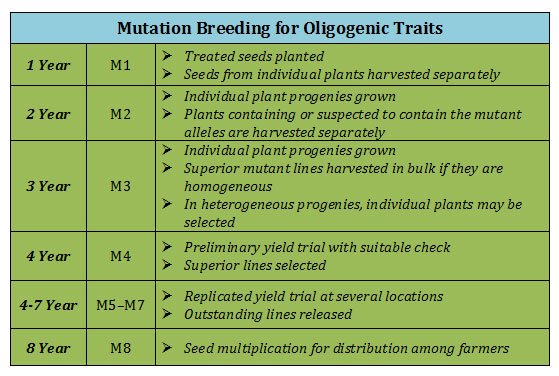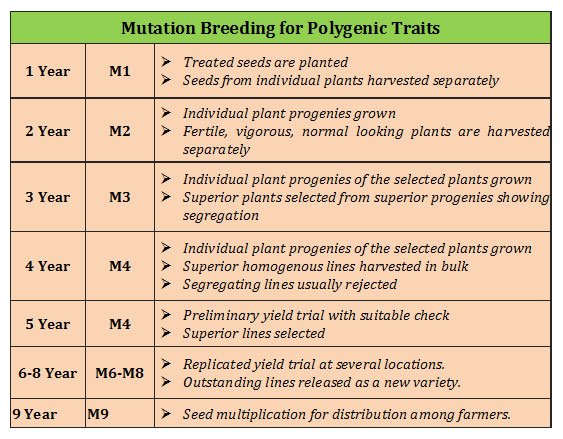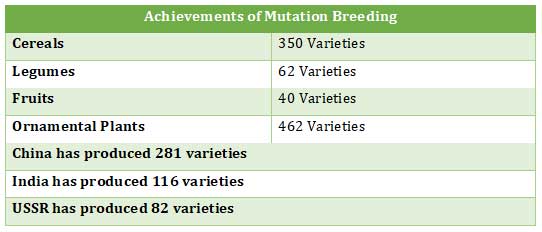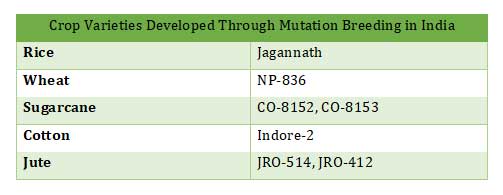Mutation breeding is a type of plant breeding technique that involves exposing plants to radiation or chemicals in order to induce mutations in their genetic material. This process can create new genetic variations that can potentially result in desirable traits such as improved yield, disease resistance, and enhanced nutritional value. The present post discusses the process of mutation breeding in crop improvement and look into the disadvantages and advantages of mutation breeding.
Learning objectives: What is Mutation Breeding? History of Mutation Breeding, Steps in Mutation Breeding, Mutation Breeding for Oligogenic and Polygenic Traits, Advantages and Limitations of Mutation Breeding, Achievements of Mutation Breeding, Mutation Breeding in India, Induced Mutations for Crop Improvement.
Learn more: Mutagens- Physical, Chemical & Biological Mutagenic Agents
What is Mutation Breeding?
Ø Definition: “The utilization of induced mutations in crop improvement is called mutation breeding”
Ø The term mutation breeding was first coined by Freisleben and Lein in 1944 to refer to the deliberate induction and development of mutant lines for crop improvement.
History of Mutation Breeding
Ø The term mutation was for the first time introduced by Hugo de Vries.
Ø The mutagenic activities of X-rays were first described by Muller on Drosophila melanogaster (Nobel Prize).
Ø Stadler and Baoley described the mutagenic activity of γ- rays.
Learn more: Comparison of Alpha, Beta and Gamma Rays
Ø Auerbach and Rohion proposed the mutagenic ability of mustard gas (Sulfur mustard).
Ø Nilsson Ehle initiated the mutation breeding programme in USSR for the first time.
Learn more: What is Gamma Garden?
Mutation Breeding
Ø The utilization of induced mutation in crop improvement is called mutation breeding.
Ø In mutation breeding, desirable mutations are induced in crop plants with the use of physical or chemical mutagens.
Ø The variability generated through induced mutations are either released as new variety or used as the parent for subsequent hybridization programmes.
Ø Treating of biological materials with mutagens to induce mutation is called mutagenesis.
Ø If any class of radiations are used as a mutagen to induce mutation in crop plants, the exposure of biological organism to the radiation is called irradiation.
Ø Mutation breeding programme should be clearly planned and should be large enough with sufficient facilities to screen large population.
Steps in Mutation Breeding
(1). Objectives of the programme
Ø Mutation breeding should have well defined and clear-cut objectives.
Learn more: Objectives of Plant Breeding
(2). Selection of the varieties for mutagen treatment
Ø The variety selected should be the best variety available.
(3). Part of the plant to be treated
Ø Seeds, pollen, vegetative propagules, sometimes complete plant as treated with mutagen
Ø The selection of plant part varies with crop plant.
Ø Seeds are best part in sexually reproducing plants.
Ø Seed treatment is the treatment of embryo.
(4). Dose of mutagen
Ø The mutagen treatment reduces germination, growth rate, vigour and fertility of organism.
Ø The mutation also increases frequency of chromosomal changes, mitotic and meiotic irregularities in the organism
Ø All these damages increase with increase in the dose mutagen and duration of exposure.
Ø Thus, the dose should be optimized for a maximum success rate
Ø The dose and treatment duration of mutagens varies with crop and plant parts and also with the type of mutagen used.
Ø The optimum dose is the dose at which maximum frequency of mutation will occurs with minimum killing of the organism.
Ø The optimum dose of mutagen is expressed as LD50.
Ø LD50: Dose of mutagen which will kill 50% of treated individuals.
Ø LD50 varies with crop plants and type of mutagen used.
(5). Giving mutagen treatment
Ø M1: generation produced directly from mutagen treated plant parts.
Ø M2, M3 & M4 are subsequent generation derived from M1, M2 and M3.
Ø M2, M3 & M4 are produced by selfing or clonal propagation.
(6). Handling mutagen treated population
Ø Mutation treatment in seeds and vegetative propagules produce chimeras.
Ø Mutation usually occurs in small section of plant parts such as seeds or meristem.
Ø One or more clonal or sexual generations with selection are necessary for stable mutant phenotype.
Ø Mutant alleles are generally recessive. Dominant mutation do occurs, however, the chance of dominant mutation is very less.
Ø In sexually reproducing plants dominant and recessive mutations are useful.
Ø However, in clonal propagated plants, the dominant mutations are beneficial.
| You may also like NOTES in... | ||
|---|---|---|
| BOTANY | BIOCHEMISTRY | MOL. BIOLOGY |
| ZOOLOGY | MICROBIOLOGY | BIOSTATISTICS |
| ECOLOGY | IMMUNOLOGY | BIOTECHNOLOGY |
| GENETICS | EMBRYOLOGY | PHYSIOLOGY |
| EVOLUTION | BIOPHYSICS | BIOINFORMATICS |
Mutation Breeding for Oligogenic Traits
Ø Mutation breeding is most used to improve the qualities of a crop plant which are controlled by oligogenic traits.

Mutation breeding for Polygenic Traits
Ø Mutagenesis also produces genetic variations in polygenic traits.
Ø This variation is however 50% less than that generated in F2 generation

Advantages of Induced Mutations in Crop Improvement
Ø Mutation breeding can be used for both oligogenic and polygenic traits in plants.
Ø It improves morphological and physiological characters of cultivated crops.
Ø Mutation breeding can improve the disease resistance of crop plants.
Learn more: Vertical Resistance vs Horizontal Resistance
Ø Induced mutations can induce desirable mutant alleles in crop plants.
Ø Mutation breeding can be used to improve the specific characters of a well-adapted high yielding variety.
Ø Quantitative characters characteristics of crop plants including yield can be improved by induced mutations.
Ø The F1 hybrids obtained from inter varietal cross are treated with mutagen to increase variability.
Learn more: Terminologies in Genetics and Plant Breeding
Ø Mutation breeding can effective to disseminate an undesirable character from a crop variety.
Limitations / Disadvantages of Mutation Breeding
Ø The frequency of desirable mutation will be very low (0.1 % of total mutations).
Ø The breeder must screen a large population to select a desirable mutation.
Ø Desirable mutations are commonly associated with undesirable side effects.
Ø Mutations often produce pleiotropic effects.
Ø Mutation in quantitative traits is usually in a direction away from the selection history of the parent variety.
Ø There may be problems in registration of mutant variety in many parts.
Ø Most of the mutations are recessive and their effects are not expressed due to the dominance of its allelic counterpart.
Achievements of Mutation Breeding
Ø Many crop varieties have been produced by mutation breeding all over the world.

Mutation breeding in India
Ø Till 1990, 219 mutant varieties of crop plants have been produced in India.
Ø Among which 116 are seed propagated and 103 vegetative propagated plants.
Crop varieties produced in India by Mutation Breeding

Ø Jagannath is a gamma semi dwarf mutant from tall cultivar T-141.
Ø Jagannath has improved resistance to lodging, high yield, more responsive to fertilizers than its parent.
Ø In wheat, NP-836 is an awned mutant from the awn-less seed variety NP-799.
Ø Sugarcane CO-8152 is a gamma induced mutant from CO-527.
Ø CO-8152 has 40% more yield than the parent.
<< Back to Plant Breeding Notes
| You may also like... | ||
|---|---|---|
| NOTES | QUESTION BANK | COMPETITIVE EXAMS. |
| PPTs | UNIVERSITY EXAMS | DIFFERENCE BETWEEN.. |
| MCQs | PLUS ONE BIOLOGY | NEWS & JOBS |
| MOCK TESTS | PLUS TWO BIOLOGY | PRACTICAL |
Dear readers
Hope this article helped you to understand the Concept of Mutation Breeding. I would like to take this opportunity to request your feedback and COMMENTS on the topics I have covered. Whether you have a suggestion, a question about the topic, or simply want to share your thoughts, I would love to hear from you. So, please don’t hesitate to leave a comment below. I appreciate your support and look forward to hearing from you.
Best regards, [Admin, EasyBiologyClass]

This is exactly what I was looking for.. thank you 🙂
Very helpful…. Well explained and straight to the point
Thank you
बहुत ही सहायता मिला इस नोट्स से बहुत बहुत धन्यवाद
Sufficient information 😊
What year was this article written pls?
Brief and crisp. To the point. Really useful for exam point
Thank you Jaseela
Keep visit easybiologyclass
helpful…
Very helpfull notes
Excellent
Excellent. I would like to get all info.